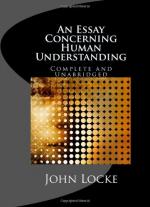18. The secondary exist in things only as modes of the primary.
A piece of manna of a sensible bulk is able to produce in us the idea of a round or square figure; and by being removed from one place to another, the idea of motion. This idea of motion represents it as it really is in manna moving: a circle or square are the same, whether in idea or existence, in the mind or in the manna. And this, both motion and as figure, are really in the manna, whether we take notice of primary, them or no: this everybody is ready to agree to. Besides, manna, by the bulk, figure, texture, and motion of its parts, has a power to produce the sensations of sickness, and sometimes of acute pains or gripings in us. That these ideas of sickness and pain are not in the manna, but effects of its operations on us, and are nowhere when we feel them not; this also every one readily agrees to. And yet men are hardly to be brought to think that sweetness and whiteness are not really in manna; which are but the effects of the operations of manna, by the motion, size, and figure of its particles, on the eyes and palate: as the pain and sickness caused by manna are confessedly nothing but the effects of its operations on the stomach and guts, by the size, motion, and figure of its insensible parts, (for by nothing else can a body operate, as has been proved): as if it could not operate on the eyes and palate, and thereby produce in the mind particular distinct ideas, which in itself it has not, as well as we allow it can operate on the guts and stomach, and thereby produce distinct ideas, which in itself it has not. These ideas, being all effects of the operations of manna on several parts of our bodies, by the size, figure, number, and motion of its parts;—why those produced by the eyes and palate should rather be thought to be really in the manna, than those produced by the stomach and guts; or why the pain and sickness, ideas that are the effect of manna, should be thought to be nowhere when they are not felt; and yet the sweetness and whiteness, effects of the same manna on other parts of the body, by ways equally as unknown, should be thought to exist in the manna, when they are not seen or tasted, would need some reason to explain.
19. Examples.
Let us consider the red and white colours in porphyry. Hinder light from striking on it, and its colours vanish; it no longer produces any such ideas in us: upon the return of light it produces these appearances on us again. Can any one think any real alterations are made in the porphyry by the presence or absence of light; and that those ideas of whiteness and redness are really in porphryry in the light, when it is plain it has no colour in the dark? It has, indeed, such a configuration of particles, both night and day, as are apt, by the rays of light rebounding from some parts of that hard stone, to produce in us the idea of redness, and from others the idea of whiteness; but whiteness or redness are not in it at any time, but such a texture that hath the power to produce such a sensation in us.




